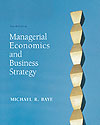This chapter examines some of the problems uncertainty
and asymmetric information add to managerial decision problems. In many instances,
consumers and firm managers have imperfect information about demand functions,
costs, sources of products, and product quality. Decisions are harder to make
because the outcomes are uncertain. If information is probabilistic in nature,
managers should take the time to calculate mean, variance, and standard deviation
of outcomes that will result from alternative actions. By doing this, they often
can use marginal analysis to make optimal decisions. Consumers and producers have different risk preferences.
Some people like to go to the mountains to ski treacherous slopes, while others
prefer to sit in the lodge and take in the scenery outside. Similarly, some
individuals have a preference for risky prospects, while others are risk averse.
If the manager has a preference for not taking risks (i.e. is risk averse),
he or she will accept projects with low expected returns, provided the corresponding
risk is lower than projects with higher expected returns. However, if risk-taking
excites the manager, he or she will be willing to take on riskier projects. Risk structures and the use of means and variances also
help identify how customers will respond to uncertain prospects. For example,
those individuals who most actively seek insurance and are willing to pay the
most for it frequently are bad risks. This results in adverse selection. Moreover,
once individuals obtain insurance, they will tend to take fewer precautions
to avoid losses than they would without it. This creates a moral hazard. We also examine how consumers will react to uncertainty
about prices or quality through search behavior. Consumers will change their
search for quality and "good" prices based on both their perceptions of the
probability of finding a better deal and the value of their time. Putting this
information to work can help managers keep more of their customers. When customers
have a low value of time, lower prices are needed to keep them because their
opportunity cost of searching is low. Next, we explore some of the problems that arise in the
presence of asymmetric information. Specifically, we identify some of the common
characteristics associated with the adverse selection and moral hazard problems.
Signaling and screening are introduced as methods for mitigating the problems
associated with adverse selection. Finally, we examine auctions, which play a central role
in capitalistic economies. We cover four types of auctions: the English auction;
the Dutch auction; the first-price, sealed-bid auction; and the second-price,
sealed-bid auction. Expected revenues (or costs) vary across auction types depending
on whether bidders are risk averse and the item being auctioned has private
or affiliated values. The optimal bidding strategies and expected revenues with
different information structures are covered for each of the four auction types. | 



 2002 McGraw-Hill Higher Education
2002 McGraw-Hill Higher Education